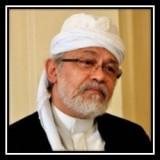The actual unfolding of the much vaunted “monotheism” of Muhammad ibn `Abdul Wahhab had none of the sublimity ascribed to it by Isma`il Faruqi in his introduction to Ibn `Abdul Wahhab’s Kitab al-Tawhid.
From the outset the emergence of Wahhabism was distinctly violent and ferocious in form. Given the nature of their brand of Tawhid (better described as a form of “monomania” rather than monotheism) it was not surprising that amongst the first acts inspired by their pious wrath was the desecration of shrines. Under the leadership of Sa`ud b. `Abdul Aziz these desecrations took place in Makkah and Madinah during the years 1803 and 1805 respectively. Prior to that, in 1802, they captured Kerbala that houses the shrine of Sayyidina Husayn (r).
In 1805 – after fifteen years of warfare – a somewhat tired Sharif of Makkah, Ghalib, entered into a negotiated settlement with Ibn Sa`ud who went on to rule the Hijaz until 1813. Nevertheless, the unremitting attempts of the Wahhabites to control, not only the Arabian Peninsula, but also its surrounding areas including Iraq, Syria, Oman, and Yemen, was cause for massive concern to the Ottomans. The Ottomans, who, at the time, had admittedly little to be said in their favour, felt that they had had enough. Muhammad `Ali of Egypt and his son Ibrahim Pasha were assigned by the Ottomans to remove the Wahhabites from the Hijaz. This they did in 1813. In 1818 Ibrahim Pasha attacked and devastated Dir’iyyah. The Wahhabites withdrew from Dir’iyyah, and, under the leadership of Turki, set up their new capital in Riyad.
This Muslim internecine fighting, however, was not to stop there. It was during this period too that the Wahhabis committed one of the worst atrocities in recent Muslim memory. That atrocity, recorded in many works, was the massacre of Muslims in Taif. This is one incident that many with Wahhabite inclinations would like to see buried. While it is not unIslamic to forgive the worst of barbarities, to forget them – or, even worse – to consciously want to bury them, is to strip oneself of human integrity and morality. We might as well start by claiming that atrocities elsewhere in the world do not happen. As Muslims we need to be bold enough to face our own indecencies and even bolder in examining its causes.
Nevertheless, it must not be assumed that these Wahhabite attacks on Muslims either averse to or expounding a different interpretation of Islam implied that they were completely united in their own quest. On the contrary, like all forms of political adventurism where power is the sole candidate there is bound to be voracious infighting. A typical example of this infighting occurred after the death of Faysal b. Turki in 1865. Between 1865 and 1877 there was an astonishing eight changes of political leadership in the house of Saud.
This reckless pursuit for power was probably spurred on by the fact that Muhammad `Abdul Wahhab’s position was that political leadership was legitimate no matter what the means employed to gain such leadership. The ends, according to his dictum, were everything; the means simply irrelevant – even if those means were meant to be writ in blood. 1891, however, saw the expulsion of the Sa`uds from Riyad. The one responsible for this was Muhammad al-Rashid of Hail who vehemently opposed Wahhabite doctrine. The Sa`uds took refuge in Kuwait.
In 1901 there was a change of fortune for the Sa`uds. `Abdul `Aziz b. Sa`ud led a party of forty in a daring raid on the governor of Riyad. The raid was a success and the governor killed while on his way to the Masjid to perform Fajr prayers. With this Riyad once again fell to the Sa`uds. `Abdul `Aziz was appointed king, consolidated the Najd, and steadily started to increase the scope of his power. In 1924 he captured the Hijaz, then the Asir region, until he finally consolidated the boundaries of present day Saudi Arabia. The blessings of oil were on their side that was discovered in Dhahran in 1938. `Abdul `Aziz signed an agreement with the USA-based Standard Oil of California to exploit the newly found oil reserves.
Despite the destructive nature of Wahhabism, `Abdul `Aziz was, nonetheless, an insightful leader that managed to return a measure of security to a country that was by then the victims of all sorts of social dangers. Not least of them being the hazardous nature of the Hajj that had its pilgrims plagued by a variety of highwaymen that derived their annual sustenance from pillaging the hard-earned wealth of those pilgrims. He also had a tough time introducing telephones to wary Bedouins who were initially convinced that these were instruments of Satan.
Returning to the theme of Wahhabism per se, recent research appears to have revealed a degree of conflict between the positions of `Abdul Wahhab himself. A few years back the Imam Muhammad bin Sa`ud University in Riyad made available a number of letters written by Muhammad ibn `Abdul Wahhab that appear to contradict the excessive nature of his declarations of kufr and shirk on those who do not espouse his cause or views. The culprit – according to the letters of Ibn `Abdul Wahhab – who spread these nefarious views, was one called Sulaiman b. Suhaim. I will recount one of the letters in full as it is quoted by Sayyid Muhammad `Alawi al-Maliki in his book Mafahim Yajib an Tusahhah.
`Abdul Wahhab states:
“Let it not be unknown to you (the people of Qasim) that the letter of Sulaiman b. Suhaim has reached your hands and that some people who profess to be `Ulama have indeed accepted and believed the contents of the letter. Allah knows that that person has fabricated and invented a number of lies against me. I have never said those things and most of those opinions have not even occurred to me. Amongst the views appearing in that letter are the following: – That I have invalidated the four Madhabs – That for 600 years all Muslims have been unbelievers – That I have appropriated the right of absolute ijtihad to myself – That I am against taqlid (adopting the opinions of other schools of thought) – That I have stated that “differences of opinion amongst the `Ulama is a curse” – That I have made Kafir those who practice intercession with the Salihin (people known for their piety) – That I have pronounced a verdict of kufr on al-Busiri (of Qasida Burdah fame) because he has referred to the Prophet in his Qasida as “O most venerated of creation” – That I have said: “Had I had the opportunity then I would have destroyed the shrine over the Prophet (s) – That had I had the opportunity then I would have removed the Mizab (spout) of the Kaba and replaced it with a wooden one – That I have declared haram visitations to the grave of the Prophet (s) – That I find reprehensible visitations to the graves of the parents of Muhammad (s) – That I have made Kafir those who swear in the name of other than Allah – That I charged with kufr both Ibn al-Farid and Ibn Arabi – That I have burnt the Dalail al-Khayrat and the Rawd al-Riyahin and that I have referred to the Rawd al-Riyahin as the Rawd al-Shayatin.
My response to all of these allegations is the Quranic verse: ‘Glory to Allah. This is indeed a serious slander! (24:16).”
These statements of Muhammad `Abdul Wahhab appear to fly in the face of the contents of his book mentioned in a previous segment of this series Kashf al-Shubahat. In the interests of scholarly fairness one would like to accept this. But there are a number of things that demand explanation.
First – even if we remove Ibn `Abdul Wahhab from the equation – is Wahhabism’s historical unfolding. Their approach, which is largely determined by their takfir of others, has resulted in massive dislocations of Muslims and the shedding of Muslim blood. This approach, coupled with the severity and extremism with which they deal with others, confirms the thesis that they are fundamentally a neo-Kharajite movement.
Second is the reality of Wahhabism as represented by their institutions today. At Madinah University, for example – and I do not imply by this that all their graduates are people who lack critical discernment – it is virtually impossible to express the views as they are apparently articulated by Muhammad ibn Abdul Wahhab in the above-quoted letter.
Third is the non-availability of these letters in published form in Saudi Arabia. Even the Mafahim of Sayyid Muhammad is not available for public consumption. The natural question is why? For whose sake and towards what end is such intellectual suppression being perpetrated? There are, however, many who believe that it is not the present-day Saudi government that is the dominant influence in the suppression of these types of literature. Given the representative nature of lecturers at Umm al-Qura University (where I graduated) there might be some credibility in this view. In fact Dr Safar al-Hawali was vehemently opposed to the appointment of many of these lecturers. They even tried to organise a protest against the textbooks prescribed at the College of Shariah. It is apparent, therefore, that there is a growing schism between those who want to espouse a moderated and modified version of Wahhabism – which is difficult since the roots of this movement are extremist – and those amongst the Wahhabite `ulama and their followers who espouse the original and more paranoid versions. The socio-political forces in that country are somewhat more complex, as I mentioned previously, than they apparently appear.
Nonetheless, and despite the nature of the debates surrounding Ibn `Abdul Wahhab’s views, his position seemed to have been sufficiently extremist, or deviant, to ignite the worst concerns of his father, brother, and teachers. One of his teachers, mentioned earlier, Shaikh Muhammad ibn Sulaiman al-Kurdi had the following to say:
O Ibn `Abdul Wahhab, I advise you, for the sake of Allahu Ta`ala, to hold your tongue against the Muslims You have no right to label the majority of Muslims as blasphemers while you yourself have deviated from the majority of Muslims. In fact it is more reasonable to regard the one who deviates from the majority as a blasphemer than to regard the Muslims as a nation as blasphemers…
The catastrophe that has been Wahhabism, and the extensive manner in which it came to dominate Islamic discourse throughout the 20th century, stand in stark vindication of those who expressed their concerns during his time.
It is against this reality as a backdrop that we will examine the impact of Wahhabism on 20th century Islam. In this regard Faruqi was quite correct when he observed that the movement of Muhammad `Abdul Wahhab “spread like wildfire throughout the Muslim world. Practically every corner was affected, but the movement assumed different names and forms in different parts of the world.”



